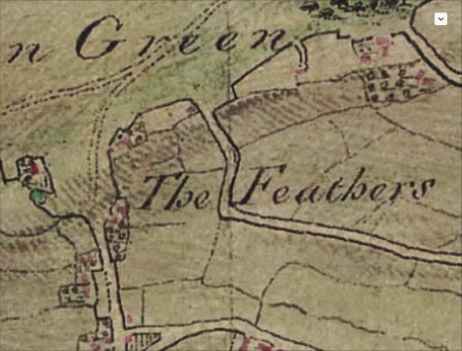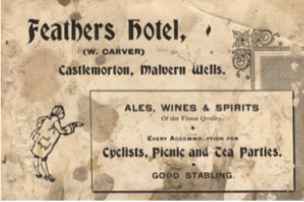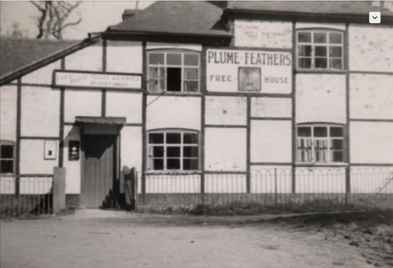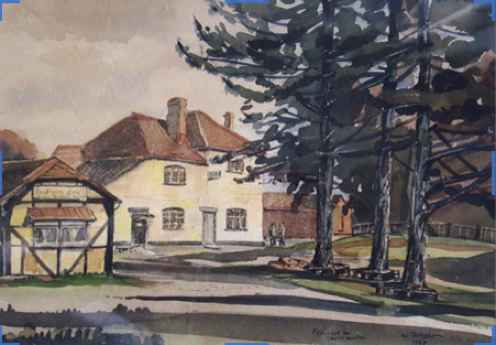THE BCH ARCHIVE
LOCAL HISTORY FOR
BIRTSMORTON
CASTLEMORTON
HOLLYBUSH
And The Surrounding District
The Plume and Feathers
Public Houses
The Plume of Feathers Public House is one of several properties
The history of them is presented together:
The Plume and Feathers Public House
Old Feathers, formerly The Old Cafe
The Farthings also known as The Annexe.
Hilldene, the bungalow bounded by the Plume of Feathers land.


The 1839 map shows a field called The Farthings, The Plume of Feathers Pub and the building now known as The Old Feathers. It is owned by the Somers Estate and occupied by Charles Beaman, who also had adjoining land.
The land was owned by the Eastnor Estate and Eastnor Archives have
Ref : 60/40 13 Jan 1773. Lease for 42 years.
Parties:- 1. Surviving Feoffees. 2. John Kerry of Powick, Cordwainer, for Hopes Patch and other properties in Castlemorton.
Ref: 60/41 4 Aug.1784 Copy lease.
Parties - 1 John Kerry. 2. Richard Mathews of Castlemorton, Victualler, for Hopes Patch and other land including the 'Plume of Feathers.'
So it must have been set up during these 11 years. Worcestershire Archives have no licensing records for this period, so the exact date it became a pub is unknown.
From at least 1808 until at least 1892, The Plume of Feathers was a regular venue for property auctions.
The 1812 Tythe Map shows an area called The Feathers, with Green Lane as a proper road to the North, coming between the words The and Feathers The field boundaries seem to bear no relation to the boundaries today. The red areas indicate buildings and it appears that the Plume of Feathers is there, not the Old Feathers, but another building nearer the road and further south.
The 1839 map shows a field called The Farthings, The Plume of Feathers Pub and the building now known as The Old Feathers. It is owned by the Somers Estate and occupied by Charles Beaman, who also had adjoining land.
In 1841, The Feathers Inn is occupied by Charles Beaman, Publican, his wife Sarah, and children Sarah and Charles.
In 1850, 20 December, prime oak, ash, elm timber for sale by auction by Robert Jones at the Feather’s Inn. Castlemorton at three’clock in the afternoon, subject to conditions comprising 620 trees in 15 lots growing on Fairoaks Farm, and other lands in the occupation of Mr William Smith, on Hunters Hall estate in the occupation of Mrs Greenway, on the Hurst Farm in the occupation of Mrs Lane, on Cutler’s Farm in the occupation of Mr. John R. Lane, on land in the occupation of Mr. Beaman of he said Feathers Inn, Holly Bush Farm in the occupation of Mr Charles Allen; and on Birts Street Farm in the occupation of Mr John Wadley, who whole of which will be described in catalogues to be had of the respective occupiers of the said farms and lands, (who will show the different lots) at the place of sale of Mr John R Lane Cutler's, of whom particulars may be known, at the Office of the Auctioneer, Ledbury This Timber sound and good quality, part of it of large dimensions, well situate for delivery, being on good roads within five miles of Upton upon Severn and close to Castlemorton and Welland Commons.
In 1851, The Feathers Inn was occupied by Charles Beaman, aged 43, Publican, from Eastnor with his wife Sarah (aged53 from Canterbury) and his niece Sarah Beaman (aged 23).
In 1852, an inquest into a local death was held at the Feathers.
In October 1855, Charles Beaman handed it over to George Taylor.
In February 1856 Mr. Gregorie, a French strong man, entertained 100 people at The Pheasant by breaking stone and iron with his fist.
In 1860, George Taylor, formerly from Grimley, father of the Landlord, died at The Feathers on 28th January.
In 1861, Charles and his wife have moved to Newland where he was farming 6 acres. The Feathers Inn was occupied by Thomas Taylor, aged 46, Inn Keeper and Farming 7 acres, from Grimley, his wife Elizabeth (aged 40 from Witherington, Herefordshire) and their daughter Elizabeth (aged 17, born Castlemorton).
On 14 September 1862 an inquest was held at the Feathers into the death of Adam Smith of Berrow. He had called in at the Feathers for cider, bread and cheese and died after being seized of I fit. The verdict was “died by visitation of God”.
In 1867, to be sold by auction by Mr R W Holtham, at the Feathers Inn, Castlemorton, on Friday, the 30th day of August, at four o'clock in the afternoon, the following pieces of pasture land, situate in the Parish of Castlemorton, the County of Worcester, in the occupation of Mr. Thomas Taylor, as yearly tenant at £25 per annum, viz.:—.
Turbill's Meadow 7 acres 3 rods 10 perches
Cobbler's Stall 1 rod 15 perches
(these adjoin the Plume of Feathers)
In Banfield Meadow 2 acres 1 rod 23 perches
There are valuable Rights of Common appurtenant to this land. It is held lease from the Reverend the Dean and Chapter of Westminster for 21 years from Michaelmas, 1863, at a Reserved Rent of 3s. 16s. per annum, and the Lease has heretofore been renewed every 7 years. It is also subject to Land Tax of 16s. per annum. The Tithe Rent Charges, 18s. 11d. per annum, are paid the Tenant. Mr. Thomas Taylor, of the Feathers Inn, Castlemorton, will show the Land. For further particulars apply to Messrs. Woodward and Pace, Pershore; Mr. Henry T. Lovegrove, or Mr. Holtham, Gloucester.
Published: Wednesday 21 August 1867
Newspaper: Worcestershire Chronicle
In 1871, the Feathers Inn was occupied by Thomas Taylor, his wife, daughter and niece Amelia Carver (aged 13).
In 1876, 22 January, an extension to hours was granted for the 24th for the Tythe Audit.
In 1881, The Feathers Hotel was occupied by Thomas Taylor, Hotel Keeper, his wife, daughter, Amelia and Samuel Dance (nephew aged 26).
In 1884, a new Lodge Oddfellows Lodge held its opening meeting at the Plume of Feathers on the last Wednesday in February.
On the 1885 First Edition Ordnance Survey Map, there is little change. A long narrow field adjoins Gloucester Road, north of the Plume of Feathers.
In 1885, a Parish Meeting was held at The Feathers.
In 1886, 3 January, the Plume of Feathers was offered for sale by auction. It cannot be Eastnor selling it, as they sold it in 1916. It is also strange if they bought it in 1885, as Lady Somers was a temperance advocate. Perhaps it failed to sell at the auction.
In 1890, the Royal St Gregory’s Lodge of Oddfellows (Manchester Unit) held their annual fete in a field next to the pub, with 100 sitting down to dinner. This continued annually until at least 1902. Below is a description of the 1896 event:
On Wednesday (20 May) the Loyal St Gregory’s Lodge of Oddfellows (Manchester Unity) held their annual fete in a field adjoining the Feathers, Castlemorton. The members assembled at 10.00am and headed by the Upton on Severn Brass Band proceeded to the Parish Church where the Vicar (Rev. E C D Fox) preached a very appropriate sermon. A call was then made on some of the principal inhabitants, after which the members returned to the lodge room, where an excellent dinner was supplied by Host Bro. Carver. Nearly 100 sat down and amongst the visitors were Rev E C D Fox and J M Donne (Welland), Dr Mountford, Messrs W Cox, C…let, Norris (Malvern), Stephen Smith, W Strawford (Birmingham), H T Powell, Pegg, Mayo, Coldson and G Jeynes. In the unavoidable absence of Colonel Long MP, through indisposition, Rev E C D Fox occupied the chair and read a letter of apology from Colonel Long. “The Grandmaster and District Officers” was proposed by Bro H E Strawford and responded to by Bro C Norris (USA) who informed them that the Order generally was in flourishing condition. Their district consisted of 11 Lodges and he referred in terms of praise to the secretary of St Gregory’s Lodge.
“The Medical Officer” was given by Mr Cox who pointed out that Dr Montford had been appointed since their last fete, but he was sure as their medical man Dr Montford would give every satisfaction.
Dr Montford responded.
“Success to the Lodge” was proposed by the Chairman who drew attention to the progress made by the juvenile portion of the Lodge. He pointed out how essential it was to any society to secure as many young members as they possibly could. With regard to the present fete, he could say that they had worked most energetically to make it a success, though meeting with many disappointments.
Bro H Strawford (Elective Secretary) responded and read the auditor’s report for the past year. He said that it was very encouraging to find the Lodge in such a flourishing condition, which was due in a great measure to the activity of their secretary, Bro W H Wilcox.
“The Honourary Members” was proposed by Mr H T Powell and responded to by Mr Cazalet who referred to old age pensions.
“The Chairman” was proposed by Mr Cox who spoke in eulogirtin terms of the Vicar. He said that he had known Mr Fox for the past twenty years and had always been willing and anxious to forward to interests of not only of the Parish generally, but of every individual under his charge.
The Chairman replied and thanked Mr Cox for his kind speech, and said that he always found the latter gentleman – who was a guardian – of great assistance to him in the Parish. He added that the Parish Council greatly relieved the clergyman of civil matters and allowed him more time for Church work.
“The Vice Chairman” was given by Mr Short, and Mr Cox briefly responded.
“The Host and Hostess” was proposed by Bro C Proctor, who alluded to the activity shown by Mr & Mrs Carver in securing prizes for their sports. Mr Carver replied. A good programme of sports was provided, but owing to inclement weather, several races had to be abandoned.
In 1891, The Feathers Inn was occupied by William Carver (Inn Keeper) aged 31 from Herefordshire with his wife Selina (nee Hammonds) from Yeovil. Thomas Taylor, retired Inn Keeper is a Boarder among with William’s sister Annie El….ck, aged 27, widow.
In 1895, 1 June, George Parker and Elias Spencer of Welland were each fines 6d plus costs for being drunk on Licenced Premises (The Feathers) on 21 May.
In 1896, Worcestershire Artillery Volunteers were staying at Castlemorton and Mr Taylor of the Feathers ran the canteen for them, although he had ceased to be Landlord by 1891.
In 1901, only District 4 of Castlemorton has been published – to the west of Gloucester Road. The east side is missing. A Trade Directory for 1900 shows William Carver as landlord. This card was found when a fireplace was removed from the front room of the pub, when Thelma was Landlady.
In 1902, a dinner for 50 gentlemen was held at The Feathers to honour John Hill, resident of the Parish for 50 years, who had served as Churchwarden for 40 years.
In 1903, Harold Gossage was fined 10s for being drunk outside The Feathers on 25th July. He had only had one drink at The Feathers. The Bench could not understand how publicans would serve people who were on the very verge of drunkenness at the risk of losing their licence, which could mean their livelihood.
On the 1905 Second Edition Ordnance Survey Map, the long field is divided in two, north and south. Some kind of small building is on the southern half.
A Trade Directory for 1906 shows Thomas Davis as landlord.
In 1911, The Feathers was occupied by Thomas Davis (b. 1861, Eastnor), Carpenter and Inn Keeper, his wife Elizabeth and grandson Raymond.
In November 1916, it was sold by auction, being the property of The Right Honourable Lords Somers. It is described as:
A Fully Licenced Road-side House and Land known as the Feathers Inn. Situate in the Parish of Castlemorton containing a well built house with ample outbuildings and 18.394 acres (or thereabouts) of productive Pasture Land and Pasture Orcharding. The house is built of brick and timber, roofed with tiles, and contains:-
On the ground floor- Bar, Taproom, Club Room, Sitting Room, Kitchen, Dairy, Store Room, Cellar and Corrugated Iron Lean-to Shed.
Upstairs – Four bedrooms and Store Room.
There is an enclosed Yard with good Drainage and Sanitary Arrangements.
The Outbuildings comprise:-
Carpenter’s Shop, 3-stall Stable, a Wood and Corrugated Iron erection including Two Loose Boxes, 2 stall Stable with loft over, Barn, Cider Mill, Trap House and Two Pigs’ Cots.
There are two enclosed Yards, Lean-to Boiler House with corrugated iron roofing, Lean-to Cart Shed with corrugated iron roofing, and an Open Shed in Orchard built of wood and corrugated iron.
The Inn is situated on the main road leading from Castlemorton to Welland and is let to Mr Thomas Davis, together with Lot 6 (Hope Orchard) at the annual rental of £60 on a yearly tenancy demon September 29th. The apportioned rent of this lot is £58 per annum.
This Lot is subject to an apportioned Tithe Rent Charge of £2:8:11d., the value for 1912 being £2:0:8d.
Schedule:
No on OS Map Name of Field Cultivation Acreage
320 The Farthings Pasture 1.693
323 Feathers Inn & Orchard 0.805
319 The Farthings Pasture (Orchard) 1.003
309 Longlands Pasture 5.788
309a Longlands Pasture 5.992
317 Spillmans Meadow Pasture 3.113
Total Acres 18.394
n 1902, a dinner for 50 gentlemen was held at The Feathers to honour John Hill, resident of the Parish for 50 years, who had served as Churchwarden for 40 years.
In 1903, Harold Gossage was fined 10s for being drunk outside The Feathers on 25th July. He had only had one drink at The Feathers. The Bench could not understand how publicans would serve people who were on the very verge of drunkenness at the risk of losing their licence, which could mean their livelihood.
On the 1905 Second Edition Ordnance Survey Map, the long field is divided in two, north and south. Some kind of small building is on the southern half.
A Trade Directory for 1906 shows Thomas Davis as landlord.
In 1911, The Feathers was occupied by Thomas Davis (b. 1861, Eastnor), Carpenter and Inn Keeper, his wife Elizabeth and grandson Raymond.
In November 1916, it was sold by auction, being the property of The Right Honourable Lords Somers. It is described as:
A Fully Licenced Road-side House and Land known as the Feathers Inn. Situate in the Parish of Castlemorton containing a well built house with ample outbuildings and 18.394 acres (or thereabouts) of productive Pasture Land and Pasture Orcharding. The house is built of brick and timber, roofed with tiles, and contains:-
On the ground floor- Bar, Taproom, Club Room, Sitting Room, Kitchen, Dairy, Store Room, Cellar and Corrugated Iron Lean-to Shed.
Upstairs – Four bedrooms and Store Room.
There is an enclosed Yard with good Drainage and Sanitary Arrangements.
The Outbuildings comprise:-
Carpenter’s Shop, 3-stall Stable, a Wood and Corrugated Iron erection including Two Loose Boxes, 2 stall Stable with loft over, Barn, Cider Mill, Trap House and Two Pigs’ Cots.
There are two enclosed Yards, Lean-to Boiler House with corrugated iron roofing, Lean-to Cart Shed with corrugated iron roofing, and an Open Shed in Orchard built of wood and corrugated iron.
The Inn is situated on the main road leading from Castlemorton to Welland and is let to Mr Thomas Davis, together with Lot 6 (Hope Orchard) at the annual rental of £60 on a yearly tenancy demon September 29th. The apportioned rent of this lot is £58 per annum.
This Lot is subject to an apportioned Tithe Rent Charge of £2:8:11d., the value for 1912 being £2:0:8d.
Schedule:
No on OS Map Name of Field Cultivation Acreage
320 The Farthings Pasture 1.693
323 Feathers Inn & Orchard 0.805
319 The Farthings Pasture (Orchard) 1.003
309 Longlands Pasture 5.788
309a Longlands Pasture 5.992
317 Spillmans Meadow Pasture 3.113
Total Acres 18.394







Note – in (Date) Field 317 was used to keep chickens.
In 1919, the occupier and probably the owner was Henry Richard William Weaver, uncle of Heerward Weaver of Mount Pleasant who bought The Joyfields that year.
In 1921, the landlord was T H Lawrence, licenced to sell beer, wines, spirit and tobacco. (Photo below – shows the pig sty that used to be the end of the café. The mail box was in the pig sty wall). The stone wall on the right used to continue from Gloucester Rod to the pub, so that top lawn must have been purchased from Feathers Pitch Cottage after this date.
A Trade Directory for 1928 shows George Edward Jones as landlord.
From the early 1930’s The Feathers was run by Arthur Taylor Davies (b. 1876 Aston). He was sold up and moved to Castlemorton with his son Owen after his wife died. He had two other sons - Eric who lived in Birmingham and Raymond who lived in Cheltenham. They visited him at the pub.
He had an old Fairbanks 2 Stationary Engine which has under wraps next to the pub and Francis Mear helped him sell it to Pat Maylin from Evesham.
His son Owen Davies (1913-1964) who married Ada Wadley (nee Jeynes, who lived at Feathers Pitch Cottage) (1911-1976) took over just before the war. Ada had lived at Feathers Pitch Cottage, next to the pub. They had two children – Thelma and David.
Thelma and David grew up at the pub. On David’s first day of school he ran through the pub and tripped over the military packpacks in the passageway and broke his arm. The soldiers were staying at Eastnor during the war and were frequent customers at the Plume of Feathers. They often brought ‘treats’ for David and Thelma and also brought lots of food that was being rationed at the time eg large tins of coffee and chocolate. Thelma remembers that on her birthday they lifted her up onto one of the tables and sang Happy Birthday to her. They also emptied their pockets of all the change and gave it to her.
Thelma married Peter Wilkes in 1956 and from 1959 onwards they ran the pub together. They had three children: Belinda, Janet and Shirley. Unfortunately Janet died aged 3 months and is buried at St Gregory’s.
Dora Grainger, who lived at Penbode, remembers the pub when Thelma and Pete lived in the ‘left had section’. She recalls the lower part of the back wall of the privy being open and everything running away down the hill. The pub had a small room with a counter for serving, on the left of the door, and another small room with bench seating on the right. The buildings between the post box and the pub were barns and a grinding stone was there, which Thelma now has in her front garden.
Pete’s mother Dorothy was born in London SE and came to Berrow the first day war was declared – September 3rd 1939. She left her husband, Jack in London. Dorothy travelled by train from Paddington to Gloucester with her son, Peter, aged 4. She did not know a soul. She had never been to Gloucestershire or Worcestershire. She only came after a neighbour recommended she go to Mrs Phillis Bridal, Pendock Cottage, Berrow as an evacuee. The bus from Gloucester dropped her at Pendock Cross and she had no idea where to go. The late Mr Clarke, who used to own the garage in Pendock, approached her and asked if he could help and showed her the way to Mrs Bridal’s. Mrs Bridal made both of them very welcome and they stayed for 7 weeks. Then they lived with Mrs R Hill at Holiday Farm, Berrow as Dorothy’s sister asked Dorothy to also look after her 6 ½ year old son, Colin. Colin stayed with Dorothy until the war had ended. After a couple of years Jack was offered a job at Hawker Sidley Aircraft, Brockworth, Gloucester and moved to the area. Dorothy and Jack’s house in London was in the same street as Dorothy’s mother and both houses were bombed and destroyed during the war. They decided they never wished to live anywhere else but Castlemorton.

Painted in 1968, this picture is held by Thelma Wilkes. It was taken by the artist into the pub and exchanged for a drink
